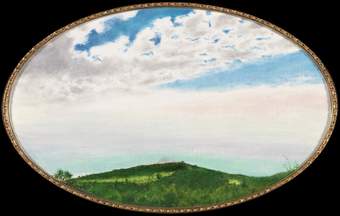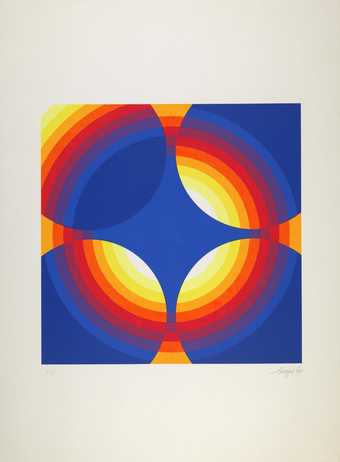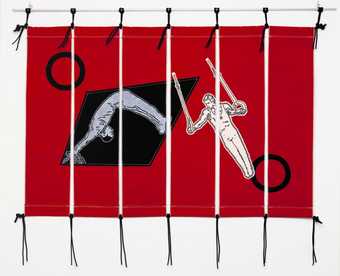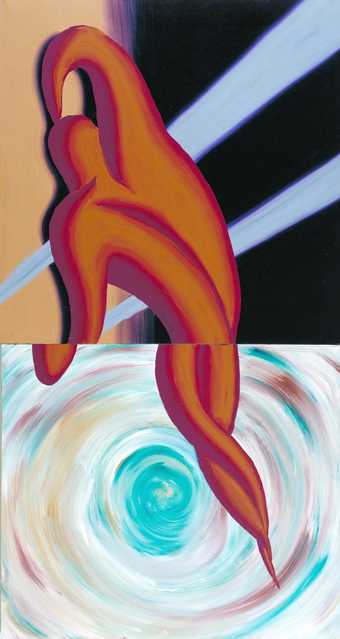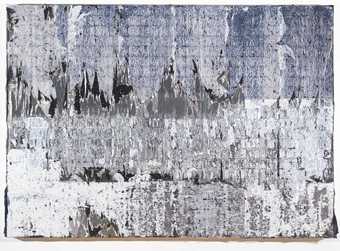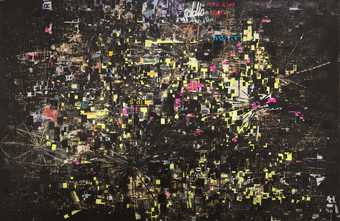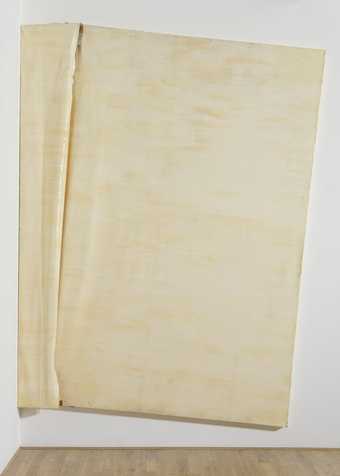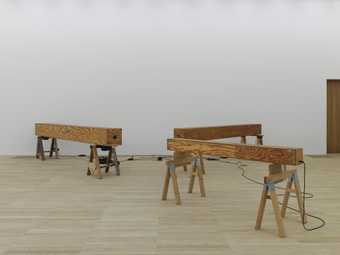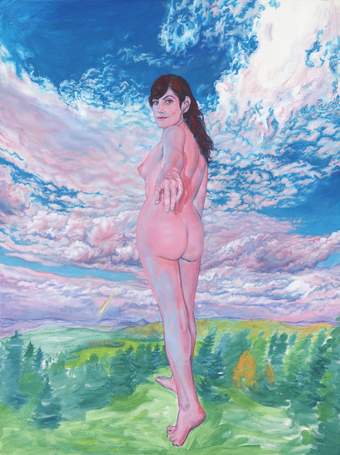Not on display
- Artist
- Silke Otto-Knapp 1970 – 2022
- Original title
- Eine aufeinander folgende Reihe von Bildern
- Medium
- Watercolour on canvas
- Dimensions
- Overall display dimensions variable
- Collection
- Tate
- Acquisition
- Purchased with funds provided by The Joe and Marie Donnelly Acquisition Fund 2019
- Reference
- T15346
Summary
A series of images following one from the other. Eine aufeinander folgende Reihe von Bildern is a large-scale, multi-panel painting produced in 2018. It is painted using watercolour paint on primed acrylic canvas and depicts group compositions of figures in choreographed poses alongside abstract shapes and forms. The painting was commissioned for the 2018 Liverpool Biennial and designed to fit the dimensions of the fourth-floor gallery of the Bluecoat, Liverpool. An accompanying artist’s book was produced which was displayed in the historic women’s common room at the Victoria Gallery & Museum, Liverpool for the duration of the biennial. Both vertical and horizontal in format and of the same height but varying width, the thirteen panels that comprise the work are installed together in a sequence like a classical frieze and can be displayed across one, two, three or four walls, as long as no single panel is shown on a wall on its own.
With an ongoing interest in materials and material processes, Otto-Knapp has become known for her singular approach to painting technique. Applying watercolour – a medium usually associated with paper and the spontaneity of sketching – to a carefully acrylic-primed canvas, the artist develops her subjects through a complex process of paint application and removal, described by curator Kitty Scott as ‘a kind of anti-painting’ (Kitty Scott in Otto-Knapp 2018, p.16.) Layers of pigment are repeatedly applied to the canvas before being washed away, resulting in a hazy, tactile surface that is developed over time. Speaking about her process, Otto-Knapp has said:
I paint the motif and then remove it by dissolving the watercolour with water. This causes the pigment to float on the surface of the canvas and allows me to control the drying process … At first I only retain a trace of the original motif but as this process is repeated, the pigment settles on the canvas in areas I’m not working on. Incrementally, through repetition, the motif appears in the pictorial space as it moves from positive to negative space. As it becomes more pronounced, I begin to focus on the removal process by using sponges or brushes or fingers in order to produce a stronger contrast between lighter and darker areas. Light and opacity are created by removing and accumulating pigment over time, a process I liken to sedimentation.
(Otto-Knapp 2018, p.16.)
Since the mid-2010s Otto-Knapp has moved away from coloured pigments in her work, viewing the reduction of her palette as a way to eliminate detail and simplify her motifs. Whilst works such as A series of images following one from the other appear to have been painted with both black and white pigments, however, the subtle graduations of tone are in fact achieved using just one paint – a watercolour pigment called ‘lampblack’ – which results in a graphite-like surface finish when subject to the artist’s specific painting technique. The artist has said: ‘I like the way the lampblack gets washed out and accumulates. It almost looks like printer ink or charcoal.’ (Otto-Knapp 2018, p.5.) Since Otto-Knapp rotates the canvas to control and direct the flow of drying watercolour paint as she works, the size of each individual painting is dictated by the span of her outstretched arms. The large scale of A series of images following one from the other is therefore achieved by producing multiple panels which are hung together to form the whole work.
Eleven of the panels depict compositions of figures enacting different types of movement, whilst the first and last panel bookend the sequence with illustrations of abstract shapes, reminiscent of birds, theatre set A-frames or gymnastic equipment. Otto-Knapp has a longstanding interest in choreographed movement, and collated material from her archive of printed and digital sources to create constellations of figures for the painting’s composition. Classical ballet is a frequent reference point in her work, and the positions, austere costumes and capped heads of the figures in the third and twelfth panel evoke Bronislava Nijinska’s choreography for Igor Stravinsky’s ballet Les Noces (1923), as well as the costumes designed by the Russian painter Natalia Goncharova (1881–1962) for its first performance by Diaghilev’s Ballet Russes in Paris in 1923. Otto-Knapp equally references contemporary dance and includes allusions to the American choreographer Yvonne Rainer’s Continuous Project Altered Daily 1969, suggested by the acrobatic forms in panel five, as well as citations from British choreographer Michael Clark’s Who’s Zoo?, illustrated by the figures in the second, ninth and eleventh panels who stand with their feet apart and hands in a clapping motion above their heads (Otto-Knapp 2018, p.15). This work was developed during a residency that Michael Clark and his dance company undertook at Tate Modern, London in the summer of 2010 with a large group of non-professional dancers as well as members of the public. Otto-Knapp was both a viewer and performer in this project, participating in all the open rehearsals that took place in Tate Modern’s Turbine Hall. Panel six, which depicts figures in balletic poses symmetrically arranged across the canvas, is a reference to a more recent Michael Clark piece that the artist viewed in performance at the Barbican Centre in London. These quotations are interspersed with what the artist terms depictions of ‘everyday movements’ such as ‘walking, standing or resting’ (Otto-Knapp 2018, p.13).
Whilst the motifs in some panels can be read in isolation, the total experience of the work is that of a single choreography; a series of bodily movements that unfold sequentially around the room and – due to the size of the painting – cannot all be viewed at the same time. Otto-Knapp also makes effective use of positive and negative space, alternating between the two from one panel to the next to link motifs together and create a sense of fluidity. This is a quality of the work reflected by its title (which the artist has chosen to give in both English and German), a phrase adopted from German art historian and cultural theorist Aby Warburg’s notes on ‘Spectator and Movement’ of 1890, in which he said: ‘To attribute motion to a figure that is not moving, it is necessary to reawaken in oneself a series of experienced images following one from the other – not a single image.’ (Cited in Otto-Knapp 2018, p.14.) As Otto-Knapp has summarised, for both Warburg and herself, ‘the emphasis is on the following of one from the other, not only on the images themselves’ (Otto-Knapp 2018, p.14).
Further reading
Present time exercise, exhibition catalogue, Modern Art Oxford, 4 July–13 September 2009.
Silke Otto-Knapp, A series of images following one from the other. Eine aufeinander folgende Reihe von Bildern, artist’s book, 18 pages, edition of 700, Berlin 2018.
Hannah Johnston
November 2018
Does this text contain inaccurate information or language that you feel we should improve or change? We would like to hear from you.
You might like
-
Barkley L. Hendricks Cold Day on the Mountain
2006 -
Herbert Bayer One Reversed
1969 -
John Dugger Sports Banner
1980 -
Alan Green One to Four
1982 -
Jedd Garet To Rule the World
1985 -
Gary Hill Remarks on Color
1994 -
Nathan Oliveira Stelae #21
1993 -
Mark Bradford May Heaven Preserve You From Dangers and Assassins
2010 -
Mark Bradford Los Moscos
2004 -
Angela de la Cruz One Painting
1999 -
Mike Kelley Channel One, Channel Two, and Channel Three
1994 -
Nash Glynn Self Portrait with One Foot Forward and One Hand Reaching Out
2020


